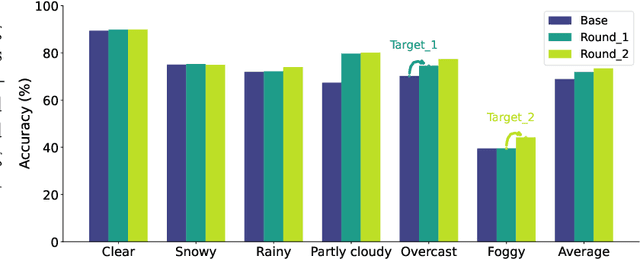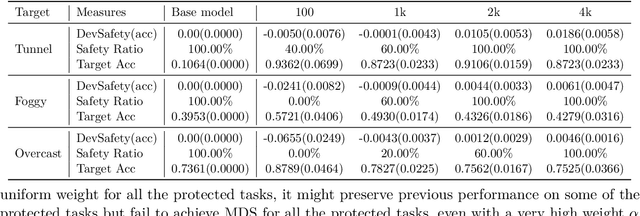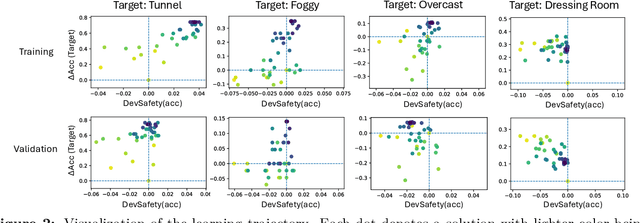Tianbao Yang
Michigan State University
Discovering Global False Negatives On the Fly for Self-supervised Contrastive Learning
Feb 28, 2025Abstract:In self-supervised contrastive learning, negative pairs are typically constructed using an anchor image and a sample drawn from the entire dataset, excluding the anchor. However, this approach can result in the creation of negative pairs with similar semantics, referred to as "false negatives", leading to their embeddings being falsely pushed apart. To address this issue, we introduce GloFND, an optimization-based approach that automatically learns on the fly the threshold for each anchor data to identify its false negatives during training. In contrast to previous methods for false negative discovery, our approach globally detects false negatives across the entire dataset rather than locally within the mini-batch. Moreover, its per-iteration computation cost remains independent of the dataset size. Experimental results on image and image-text data demonstrate the effectiveness of the proposed method. Our implementation is available at https://github.com/vibalcam/GloFND .
Discriminative Finetuning of Generative Large Language Models without Reward Models and Preference Data
Feb 25, 2025Abstract:Supervised fine-tuning (SFT) followed by preference optimization (PO) denoted by SFT$\rightarrow$PO has become the standard for improving pretrained large language models (LLMs), with PO demonstrating significant performance gains. However, PO methods rely on either human-labeled preference data or a strong reward model to generate preference data. Can we fine-tune LLMs without preference data or reward models while achieving competitive performance to SFT$\rightarrow$PO? We address this question by introducing Discriminative Fine-Tuning (DFT), a novel approach that eliminates the need for preference data. Unlike SFT, which employs a generative approach and overlooks negative data, DFT adopts a discriminative paradigm that that increases the probability of positive answers while suppressing potentially negative ones, shifting from token prediction to data prediction. Our contributions include: (i) a discriminative probabilistic framework for fine-tuning LLMs by explicitly modeling the discriminative likelihood of an answer among all possible outputs given an input; (ii) efficient algorithms to optimize this discriminative likelihood; and (iii) extensive experiments demonstrating DFT's effectiveness, achieving performance better than SFT and comparable to if not better than SFT$\rightarrow$PO. The code can be found at https://github.com/PenGuln/DFT.
Myna: Masking-Based Contrastive Learning of Musical Representations
Feb 19, 2025Abstract:We present Myna, a simple yet effective approach for self-supervised musical representation learning. Built on a contrastive learning framework, Myna introduces two key innovations: (1) the use of a Vision Transformer (ViT) on mel-spectrograms as the backbone and (2) a novel data augmentation strategy, token masking, that masks 90 percent of spectrogram tokens. These innovations deliver both effectiveness and efficiency: (i) Token masking enables a significant increase in per-GPU batch size, from 48 or 120 in prior methods (CLMR, MULE) to 4096. (ii) By avoiding traditional augmentations, Myna retains pitch sensitivity, enhancing performance in tasks like key detection. (iii) The use of vertical patches allows the model to better capture critical features for key detection. Our hybrid model, Myna-22M-Hybrid, processes both 16x16 and 128x2 patches, achieving state-of-the-art results. Trained on a single GPU, it outperforms MULE (62M) on average and rivals MERT-95M, which was trained on 16 and 64 GPUs, respectively. Additionally, it surpasses MERT-95M-public, establishing itself as the best-performing model trained on publicly available data. We release our code and models to promote reproducibility and facilitate future research.
AutoTrust: Benchmarking Trustworthiness in Large Vision Language Models for Autonomous Driving
Dec 19, 2024



Abstract:Recent advancements in large vision language models (VLMs) tailored for autonomous driving (AD) have shown strong scene understanding and reasoning capabilities, making them undeniable candidates for end-to-end driving systems. However, limited work exists on studying the trustworthiness of DriveVLMs -- a critical factor that directly impacts public transportation safety. In this paper, we introduce AutoTrust, a comprehensive trustworthiness benchmark for large vision-language models in autonomous driving (DriveVLMs), considering diverse perspectives -- including trustfulness, safety, robustness, privacy, and fairness. We constructed the largest visual question-answering dataset for investigating trustworthiness issues in driving scenarios, comprising over 10k unique scenes and 18k queries. We evaluated six publicly available VLMs, spanning from generalist to specialist, from open-source to commercial models. Our exhaustive evaluations have unveiled previously undiscovered vulnerabilities of DriveVLMs to trustworthiness threats. Specifically, we found that the general VLMs like LLaVA-v1.6 and GPT-4o-mini surprisingly outperform specialized models fine-tuned for driving in terms of overall trustworthiness. DriveVLMs like DriveLM-Agent are particularly vulnerable to disclosing sensitive information. Additionally, both generalist and specialist VLMs remain susceptible to adversarial attacks and struggle to ensure unbiased decision-making across diverse environments and populations. Our findings call for immediate and decisive action to address the trustworthiness of DriveVLMs -- an issue of critical importance to public safety and the welfare of all citizens relying on autonomous transportation systems. Our benchmark is publicly available at \url{https://github.com/taco-group/AutoTrust}, and the leaderboard is released at \url{https://taco-group.github.io/AutoTrust/}.
Which LLMs are Difficult to Detect? A Detailed Analysis of Potential Factors Contributing to Difficulties in LLM Text Detection
Oct 18, 2024Abstract:As LLMs increase in accessibility, LLM-generated texts have proliferated across several fields, such as scientific, academic, and creative writing. However, LLMs are not created equally; they may have different architectures and training datasets. Thus, some LLMs may be more challenging to detect than others. Using two datasets spanning four total writing domains, we train AI-generated (AIG) text classifiers using the LibAUC library - a deep learning library for training classifiers with imbalanced datasets. Our results in the Deepfake Text dataset show that AIG-text detection varies across domains, with scientific writing being relatively challenging. In the Rewritten Ivy Panda (RIP) dataset focusing on student essays, we find that the OpenAI family of LLMs was substantially difficult for our classifiers to distinguish from human texts. Additionally, we explore possible factors that could explain the difficulties in detecting OpenAI-generated texts.
Model Developmental Safety: A Safety-Centric Method and Applications in Vision-Language Models
Oct 13, 2024



Abstract:In the real world, a learning-enabled system usually undergoes multiple cycles of model development to enhance the system's ability to handle difficult or emerging tasks. This continual model development process raises a significant issue that the model development for acquiring new or improving existing capabilities may inadvertently lose capabilities of the old model, also known as catastrophic forgetting. Existing continual learning studies focus on mitigating catastrophic forgetting by trading off performance on previous tasks and new tasks to ensure good average performance. However, they are inadequate for many applications especially in safety-critical domains, as failure to strictly preserve the performance of the old model not only introduces safety risks and uncertainties but also imposes substantial expenses in the re-improving and re-validation of existing properties. To address this issue, we introduce model developmental safety as a guarantee of a learning system such that in the model development process the new model should strictly preserve the existing protected capabilities of the old model while improving its performance on target tasks. To ensure the model developmental safety, we present a safety-centric framework by formulating the model developmental safety as data-dependent constraints. Under this framework, we study how to develop a pretrained vision-language model (aka the CLIP model) for acquiring new capabilities or improving existing capabilities of image classification. We propose an efficient constrained optimization algorithm with theoretical guarantee and use its insights to finetune a CLIP model with task-dependent heads for promoting the model developmental safety. Our experiments on improving vision perception capabilities on autonomous driving and scene recognition datasets demonstrate the efficacy of the proposed approach.
On Discriminative Probabilistic Modeling for Self-Supervised Representation Learning
Oct 11, 2024Abstract:We study the discriminative probabilistic modeling problem on a continuous domain for (multimodal) self-supervised representation learning. To address the challenge of computing the integral in the partition function for each anchor data, we leverage the multiple importance sampling (MIS) technique for robust Monte Carlo integration, which can recover InfoNCE-based contrastive loss as a special case. Within this probabilistic modeling framework, we conduct generalization error analysis to reveal the limitation of current InfoNCE-based contrastive loss for self-supervised representation learning and derive insights for developing better approaches by reducing the error of Monte Carlo integration. To this end, we propose a novel non-parametric method for approximating the sum of conditional densities required by MIS through convex optimization, yielding a new contrastive objective for self-supervised representation learning. Moreover, we design an efficient algorithm for solving the proposed objective. We empirically compare our algorithm to representative baselines on the contrastive image-language pretraining task. Experimental results on the CC3M and CC12M datasets demonstrate the superior overall performance of our algorithm.
An Efficient Contrastive Unimodal Pretraining Method for EHR Time Series Data
Oct 11, 2024Abstract:Machine learning has revolutionized the modeling of clinical timeseries data. Using machine learning, a Deep Neural Network (DNN) can be automatically trained to learn a complex mapping of its input features for a desired task. This is particularly valuable in Electronic Health Record (EHR) databases, where patients often spend extended periods in intensive care units (ICUs). Machine learning serves as an efficient method for extract meaningful information. However, many state-of-the-art (SOTA) methods for training DNNs demand substantial volumes of labeled data, posing significant challenges for clinics in terms of cost and time. Self-supervised learning offers an alternative by allowing practitioners to extract valuable insights from data without the need for costly labels. Yet, current SOTA methods often necessitate large data batches to achieve optimal performance, increasing computational demands. This presents a challenge when working with long clinical timeseries data. To address this, we propose an efficient method of contrastive pretraining tailored for long clinical timeseries data. Our approach utilizes an estimator for negative pair comparison, enabling effective feature extraction. We assess the efficacy of our pretraining using standard self-supervised tasks such as linear evaluation and semi-supervised learning. Additionally, our model demonstrates the ability to impute missing measurements, providing clinicians with deeper insights into patient conditions. We demonstrate that our pretraining is capable of achieving better performance as both the size of the model and the size of the measurement vocabulary scale. Finally, we externally validate our model, trained on the MIMIC-III dataset, using the eICU dataset. We demonstrate that our model is capable of learning robust clinical information that is transferable to other clinics.
Communication-Efficient Federated Group Distributionally Robust Optimization
Oct 08, 2024Abstract:Federated learning faces challenges due to the heterogeneity in data volumes and distributions at different clients, which can compromise model generalization ability to various distributions. Existing approaches to address this issue based on group distributionally robust optimization (GDRO) often lead to high communication and sample complexity. To this end, this work introduces algorithms tailored for communication-efficient Federated Group Distributionally Robust Optimization (FGDRO). Our contributions are threefold: Firstly, we introduce the FGDRO-CVaR algorithm, which optimizes the average top-K losses while reducing communication complexity to $O(1/\epsilon^4)$, where $\epsilon$ denotes the desired precision level. Secondly, our FGDRO-KL algorithm is crafted to optimize KL regularized FGDRO, cutting communication complexity to $O(1/\epsilon^3)$. Lastly, we propose FGDRO-KL-Adam to utilize Adam-type local updates in FGDRO-KL, which not only maintains a communication cost of $O(1/\epsilon^3)$ but also shows potential to surpass SGD-type local steps in practical applications. The effectiveness of our algorithms has been demonstrated on a variety of real-world tasks, including natural language processing and computer vision.
Multi-Output Distributional Fairness via Post-Processing
Aug 31, 2024



Abstract:The post-processing approaches are becoming prominent techniques to enhance machine learning models' fairness because of their intuitiveness, low computational cost, and excellent scalability. However, most existing post-processing methods are designed for task-specific fairness measures and are limited to single-output models. In this paper, we introduce a post-processing method for multi-output models, such as the ones used for multi-task/multi-class classification and representation learning, to enhance a model's distributional parity, a task-agnostic fairness measure. Existing techniques to achieve distributional parity are based on the (inverse) cumulative density function of a model's output, which is limited to single-output models. Extending previous works, our method employs an optimal transport mapping to move a model's outputs across different groups towards their empirical Wasserstein barycenter. An approximation technique is applied to reduce the complexity of computing the exact barycenter and a kernel regression method is proposed for extending this process to out-of-sample data. Our empirical studies, which compare our method to current existing post-processing baselines on multi-task/multi-class classification and representation learning tasks, demonstrate the effectiveness of the proposed approach.
 Add to Chrome
Add to Chrome Add to Firefox
Add to Firefox Add to Edge
Add to Edge